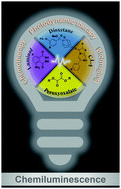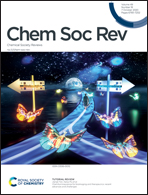Chemiluminescence for bioimaging and therapeutics: recent advances and challenges
Abstract
Chemiluminescence, the generation of light through chemiexcitation as a result of chemical reactions, has emerged as a novel tool for bioimaging and therapy in vivo. Due to the elimination of external optical excitation, it can effectively avoid background autofluorescence existing in fluorescence techniques, providing extremely high signal-to-noise ratios and sensitivity in bioimaging. Furthermore, in situ emitted photons can replace traditional excitation light to construct chemiexcited photodynamic therapy or drug release systems for the monitoring and treatment of deeply seated diseases or tumors. In this tutorial review, we will focus on the recent advancements of chemiluminescent platforms based on luminophore substrates including luminol and its derivatives, cypridina luciferin analogs, peroxyoxalates, and dioxetanes, and systematically summarize the design principles, sensing mechanisms, and bioimaging and therapeutic applications of representative chemiluminescent probes as well as theranostic agents. Finally, the potential challenges and perspectives of chemiluminescent platforms for bioimaging and therapeutics are also discussed.



 Please wait while we load your content...
Please wait while we load your content...